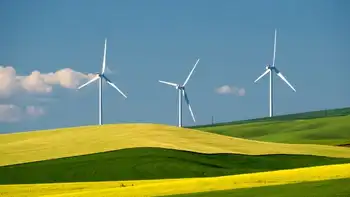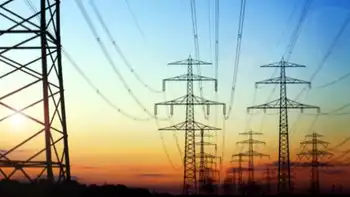TVA returning to energy efficiency roots
By The Tennessean
CSA Z463 Electrical Maintenance -
Our customized live online or in‑person group training can be delivered to your staff at your location.

- Live Online
- 6 hours Instructor-led
- Group Training Available
As a result of the decades-long lag, Tennesseans use more residential electricity per person than any other state except Alabama. In contrast, utilities in several other parts of the country have embraced efforts to reduce electricity use by customers, leapfrogging TVA and offering a wide array of programs designed to save energy.
For example, the city-run electric utility in Austin, Texas, put measures in place over the past 25 years that saved more electricity than a new power plant would generate.
In contrast, TVA continued on a nuclear power spending program, approving $2.5 billion last year to complete a new nuclear reactor at Watts Bar in East Tennessee. It spent $1.8 billion to restart another nuclear unit last year in Alabama. The agency also paid out $1 billion last year to buy electricity outside its own grid.
Only after committing billions to increasing nuclear power has the agency made a serious pledge to promote efficiency as part of its overall strategy. And the $36 million it has set aside this year to do so is only a fraction of the amount going for more nuclear power.
The agency insists there's no way around the need for more power, but concedes it needs to concentrate on energy efficiency and reducing demand in combination with its nuclear program.
"Relative to what's going on in the rest of the country, we are behind," said TVA's Joe Hoagland, who was named vice president of energy efficiency and demand response last fall. "But we haven't had the price and reliability issue that some places have."
There Was Little Incentive
That lack of emphasis on conservation is evident, especially for those who have lived elsewhere.
"There doesn't seem to be any kind of awareness — period — except for small pockets of people throughout the city who in some cases did live somewhere else and brought that awareness to Nashville," said Judy Wilson, of East Nashville, who owns a Web development company. She lived in environmentally conscious San Francisco for 17 years.
Why has TVA been largely missing from the conservation game? The agency — like most utilities — had little incentive to encourage consumers to use less power.
Until recent years the TVA had enough inexpensive, reliable power, and revenues were needed to pay for expenses, planning and the more than $20 billion owed for power plant construction.
"If you see yourself as a cranker of electricity as opposed to a provider of energy services, then you have a whole different way of looking at what would benefit your customers," said John Laitner, director of economic analysis for the American Council for an Energy-Efficient Economy. "You need to diversify to include efficiency as well as supply."
Tenn. Vs. Other States
A look at how Tennessee compares with other states in electrical use is one way of gauging how the state and the TVA have faltered on the conservation front.
Tennessee uses about a quarter more residential electricity per person, on average, than Texas, for instance, according to research by the California Energy Commission.
From the late 1970s to 2005, Tennessee's per-person residential electricity use jumped 25 percent. The state is in a region where air conditioning use is heavier, which can account for some, but not all, of the differences state to state.
In contrast, California's residential electricity use rose just 5 percent per person during that same period. Though the California economy grew, the state never stopped pushing for conservation after the 1970s national energy crisis. California also is one of several states, including Texas and Vermont, that have begun requiring utilities to find ways to manage and slow increasing power use.
But TVA is different: Because it's an independent, self-supporting federal agency, the state government couldn't mandate it to act even if it wanted to. The state legislature asked — by way of a non-binding resolution last year — that the agency make a major investment in energy efficiency.
In the past year, the TVA board has — coincidentally or not — committed to reducing carbon and energy use by its customers and itself. The goal is a 1,400-megawatt reduction in peak electricity use within five years. That's more energy than a new nuclear reactor would produce and enough for more than 650,000 homes. And TVA last month set a goal of generating half its power from low- or non-carbon-producing sources by 2020.
The contrast with several states, however, is stark. At least 20 are already viewing energy reductions and time-of-day management of power demand as a low-cost, clean energy resource. Utilities have set up programs that include offers such as rebates for "cool roofs" that can reduce air conditioning use by 10 percent to 20 percent, and free home energy audits by professionals.
Vermont, a major conservation leader, established an independent "efficiency utility" in 2000. Its voluntary programs and incentives, which include rebates for more efficient light bulbs and appliances, have stopped growth in electricity use there and have saved homes and businesses $31 million.
"If that can be done here, it can probably be done other places," said Blair Hamilton, executive director of Efficiency Vermont.
One of the country's more aggressive programs was built in fast-growing Austin over the past 25 years. Rebates and incentives cover everything from solar screens to efficient refrigerators and zero- and low-interest loans for making a home energy efficient.
"It's cheaper for us in most cases to meet growth and demand through efficiency rather than building plants," said Matt Watson, policy director for Austin Mayor Will Wynn.
Residents have been able to put in a $20,000 solar energy system for $5,000 because of Austin's rebates and federal tax incentives, Watson said. Up to $200,000 in rebates is available for data center efficiencies at businesses.
"It's worth it to defray costs through incentives," Watson said.
TVA: Nukes Over Green
Ironically, TVA was the leader in such programs during the 1970s and '80s. Then, TVA would send workers into homes and perform energy audits to help residents become more efficient. It gave no- and low-interest loans for energy-efficient heat pumps and weatherization products, including weather stripping and insulation.
But times changed. With its new nuclear plants coming on line, and, then, a surge of independent power producers building plants, TVA had plenty of power, and less reason to encourage customers to conserve. Federal tax incentives dried up for energy efficiency programs, and the public lost interest in conservation as its memories of the '70s energy crises faded.
"TVA was the most innovative utility in the country, and then they stopped," said Alex Tapia, with the Southeast Energy Efficiency Alliance, who applauds the new effort.
"Now, they're kind of scrambling to catch up."
The Tennessee Valley Authority was established by Congress in 1933. In addition to overseeing the Tennessee River, the agency brought electrification to an area well behind much of the nation.
The relatively inexpensive electricity it has provided, has been both a boon and a problem.
Groups such as the Southern Alliance for Clean Energy have urged the agency for years to consider energy efficiency. Pressure from groups did help spark the Green Power Switch program, which allows customers of participating distributors to pay extra for renewable energy resources. TVA has put up several windmills and solar panels and is generating some electricity from methane. But taken together, those projects generate less than 1 percent of its power.
But generally, the advocates' efforts were to little avail, and the agency settled on more nuclear or other fossil fuel power, with a smattering of conservation offerings.
However, Anda Ray, TVA's vice president of environmental stewardship and policy, contends nuclear plants are a key to the future. Gains from less growth in energy demand would be used to remove from service coal plants, which add to air pollution.
Whatever is done will take a partnership with the public, she said.
"You're trading bricks and mortar for people's behavior," she said.
What TVA Is Doing Now
The TVA says a growing population, rising energy costs and mounting concerns about climate-changing pollution have triggered a shift in the utility that includes starting out with pilot programs.
"What we've done over the last six months is put together a plan to enhance and revamp our energy efficiency program," Hoagland said.
The agency has put aside $36 million for this fiscal year for energy efficiency, with part of that for existing programs, including Green Power Switch.
Part of the money is for planning and pilot programs, including one in which customers can get cheaper rates at different times of the day when demand isn't as high.
A home audit program for residents to conduct themselves also is being offered, with free energy kits, worth $40, available for 30,000 takers. About a third are left.
The amount for efficiency and demand timing programs could go well over $100 million in the future, TVA's President and CEO Tom Kilgore has said.
Tapia, with the Southeast Energy Efficiency Alliance, said TVA is on track again. The plans officials have announced are "enough, given that it's the first step in a long-term program."
If TVA doesn't follow through, the risk is dirtier air, more mountaintops blown up to mine coal, and increased global warming, he said.
Agreeing with him was John Noel, a Nashville businessman and president of the Southern Alliance for Clean Energy.
"TVA is behind the energy conservation curve, but they are implementing systems and programs at a faster pace than most any utility in the country," he said.
Building nuclear reactors could be sidelined while efficiencies are sought along with alternative power sources, such as more solar and cogeneration, he said.
"It could all add up to the fact that we do not need to build a financially risky system, such as a nuclear plant," Noel said. "This is uncharted territory for TVA, and I say it's a territory we need to venture into."











